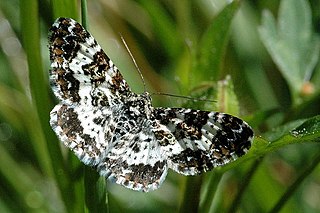
Epirrhoe tristata, the small argent and sable, is a moth of the genus Epirrhoe in the family Geometridae. The species was first described by Carl Linnaeus in his 1758 10th edition of Systema Naturae.
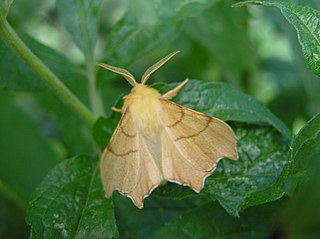
Ennomos erosaria, the September thorn, is a moth of the family Geometridae. The species can be found in the Palearctic realm in western Europe and from central Scandinavia. Its range extends to the northern Mediterranean and east to the Caucasus and Russia. It is widespread in mixed and deciduous forests in Europe. The south eastern occurrence reaches Turkey and the Caucasus. The main habitat is dry deciduous forests and parks. In the Southern Alps, the species rises to an altitude of about 1600 metres.

Orthonama vittata, the oblique carpet, is a moth of the family Geometridae. The species was first described by Moritz Balthasar Borkhausen in 1794. It is found throughout the Palearctic realm.

Eumacaria is a monotypic moth genus in the family Geometridae described by Packard in 1873. Its only species, Eumacaria madopata, the brown-bordered geometer moth, was first described by Achille Guenée in 1857. It is found in North America, where it has been recorded from British Columbia, northern Washington, southern Saskatchewan, from Maine to Florida, South Dakota, North Dakota, Nebraska, Wyoming, Idaho, Colorado and New Mexico. The habitat consists of orchards and shrublands. The species is listed as threatened in Connecticut.

Nasusina is a genus of moths in the family Geometridae.
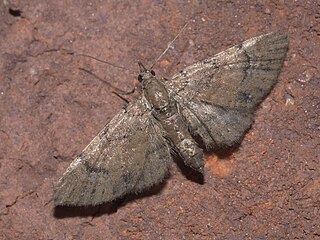
Eupithecia peckorum, or Peck's pug moth, is a moth in the family Geometridae. The species was first described by Roger L. Heitzman and Wilbur R. Enns in 1977. It is found in the United States in eastern Texas, Missouri, Mississippi and Louisiana.
Eupithecia macfarlandi is a moth in the family Geometridae first described by Clifford D. Ferris in 2007. It is found in canyons on the east side of the Huachuca Mountains in the US state of Arizona. The habitat consists of oak and oak-conifer forests.
Eupithecia penablanca is a moth in the family Geometridae first described by Clifford D. Ferris in 2007. It is found in Carr Canyon in the US state of Arizona. The habitat consists of oak chaparral forests.
Eupithecia classicata is a moth in the family Geometridae first described by Pearsall in 1909. It is found in the US state of Arizona and the Mexican state of Durango.

Eupithecia affinata is a moth in the family Geometridae first described by Pearsall in 1908. It is found in North America, including Pennsylvania, New Jersey, New York, Maryland, Maine, Michigan, North Carolina, West Virginia, Kentucky, Ontario and Quebec. It has also been recorded from Arizona and California.
Eupithecia quakerata is a moth in the family Geometridae first described by Pearsall in 1909. It is found in the US states of Colorado, Utah, New Mexico, Arizona and California.
Eupithecia exudata is a moth in the family Geometridae first described by Pearsall in 1909. It is found in the eastern United States, including Pennsylvania, Indiana, Kentucky and Ohio.
Eupithecia segregata is a moth in the family Geometridae first described by Pearsall in 1910. It is found in the US states of Oregon, Arizona and California.
Eupithecia cocoata is a moth in the family Geometridae. It is found in North America, with records from Maryland, Iowa and Washington.
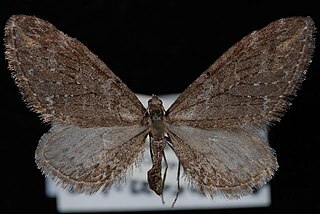
Eupithecia scabrogata is a moth in the family Geometridae first described by Pearsall in 1912. It is found in western North America from British Columbia to California and Arizona.
Eupithecia adequata is a moth in the family Geometridae first described by Pearsall in 1910. It is found in the United States from Utah and Colorado through Nevada to California and Arizona.
Nasusina inferior is a moth in the family Geometridae. It is found in southern California.
Nasusina mendicata is a moth in the family Geometridae first described by William Barnes and James Halliday McDunnough in 1918. It is found in the US in southern and central California, extending up the coast as far as Sonoma and Napa counties.
Prorella opinata is a moth in the family Geometridae first described by Pearsall in 1909. It is found in the US states of Colorado, California, Arizona, New Mexico and Utah.
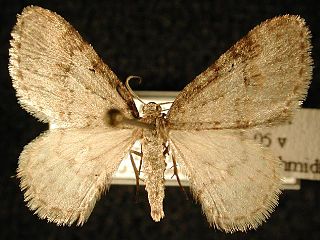
Venusia pearsalli, or Pearsall's carpet moth, is a moth in the family Geometridae. The species was first described by Harrison Gray Dyar Jr. in 1906. It is found in western North America, from Alaska, Alberta and British Columbia, through Washington and Oregon to California.








